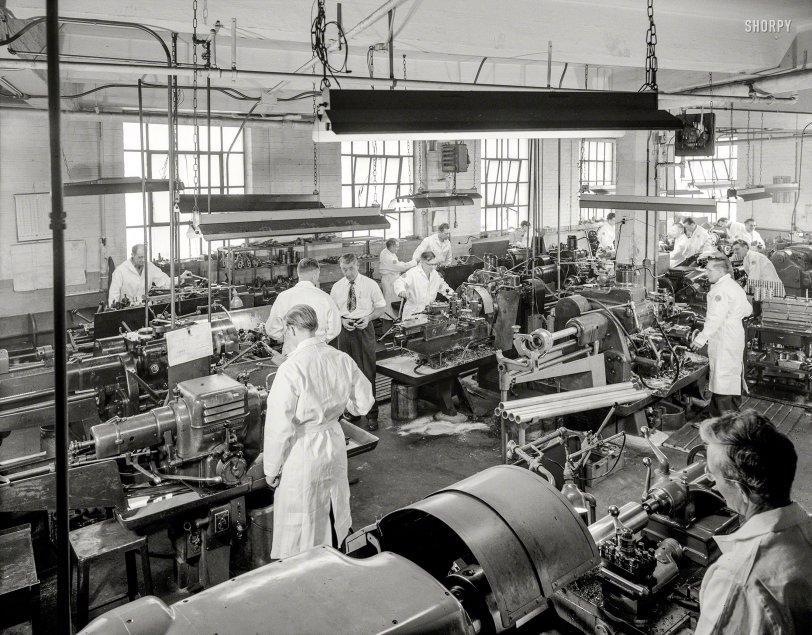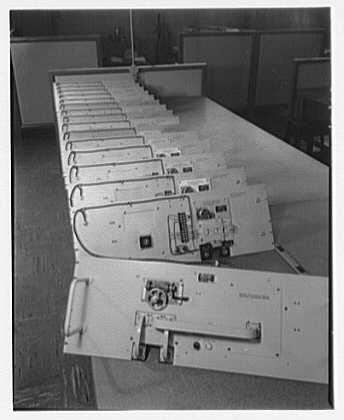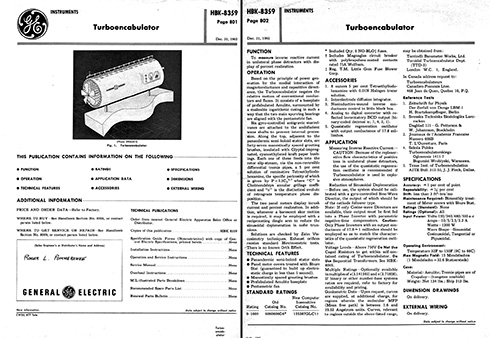


Framed or unframed, desk size to sofa size, printed by us in Arizona and Alabama since 2007. Explore now.
Shorpy is funded by you. Patreon contributors get an ad-free experience.
Learn more.

- Illuminate us
- I remember it well
- I can't prove it
- Complicated then, forgotten now
- Bryan-Stevenson
- Skinny is as skinny does
- How do you rest in peace
- Riding the footboards
- Alas, hidden from view
- Baldwin Diesels
- Exclusive pump
- Bananas, Oysters and Smokey Joe
- Details, Details
- What's that building to the left of the tower?
- Coal Barges
- Bromo-Seltzer
- Inner harbor
- The Basin
- What a headache!
- Giant stepladder?
- Yeah, it was cold
- Love those coats
- Link & Pin Days Remnant
- Baldwin 62303
- Baldwin VO-1000
- Cold
- No expense spared
- Tough Guys
- What's your hurry, where's your hat?
- Sheriff's Signature
Print Emporium
Machine Shop: 1953

Nov. 17, 1953. "F&R Machine Works, 44-14 Astoria Blvd., Long Island City, N.Y. General view from balcony. C.M. Johnson, client." Busy making whatchamacallits. Large-format acetate negative by Gottscho-Schleisner. View full size.
The smell, ooh that smell.
I spent a lot of time in machine shops very similar to this on in the 70's and it's amazing how little things changed. Even though this pic was taken a year before I was born, these manual turret lathes were likely still cranking out parts some twenty years later when I came on the scene.
One vivid memory I have of shops like that is the rancid odor of the soluble oil used in the coolant. In those days, there was no preservative in it and after a few days in the tank, it became quite rank, especially during the summer months.
Another thing that hasn't changed much over the years is the fluorescent lighting. I'm not sure when it came out, but the fixtures hanging in this shop look very similar to those hanging in my shop today.
I wouldn't do that
That tie is just begging to get sucked into one of those lathes.
You have it all wrong.
F&R Machine Works is a prototype shop for General Electric. The item you see in Mr. Horton's hand is part of a GE Turboencabulator.
Not quite a Veeblefetzer
Ray, if you look carefully, I believe you'll see that these contraptions do not have fins, unless the fin installation occurred later in the manufacturing process.
Veeblefetzers had fins, though they diminished in size as the 1950s came to a close. The non-finned versions of the Veeblefetzer were known as Potrzebies.
Whozits
Sorry Bill, they aren't whozits or whatchamacallits. As anyone can plainly see, they are thingamajigs.
Contraptions!
I can spot a contraption a mile away. The gentleman in the tie, Mr. Horton by name, is indeed holding a whozit.
Whatchamacallits
Definitely gizmos, assembled from a collection of widgets.
From whatchamacallits to tiles
Built in 1938, the building at 44-14 Astoria Boulevard has housed a tile company since 1980. F&R Machine Works seems to have vanished without an online trace. The latest reference I can find is a newspaper help-wanted advertisement from 1958, chances are it was gone soon after.
I'm Mad! Mad, I tell you!
Looks to me as if they're manufacturing Veeblefetzers. The North American Veeblefetzer's principal product enjoyed brief fame in MAD Magazine sometime in the late 1950s.... Sadly, the Veeblefetzer's purpose was -- and remains -- unknown.
Obscure
They're lathes making cylindrical parts to some spec or other, cut from longer stock.
The part is not likely to have a real name, it's just part of something else that the client is making.
Swiss screw machines would be the automatic version, for smaller parts at least. Lathes run by cams. Load them up and set them running, and a couple hours later you have a basket of output.
The automatic machines can cut angles nicely, with constant feed speed and tool insertion speed.
A small room manned by women with screen silhouette magnifiers verify the shape is correct later.
Whatchamacallits
Are you sure those aren't whozits?


























On Shorpy:
Today’s Top 5